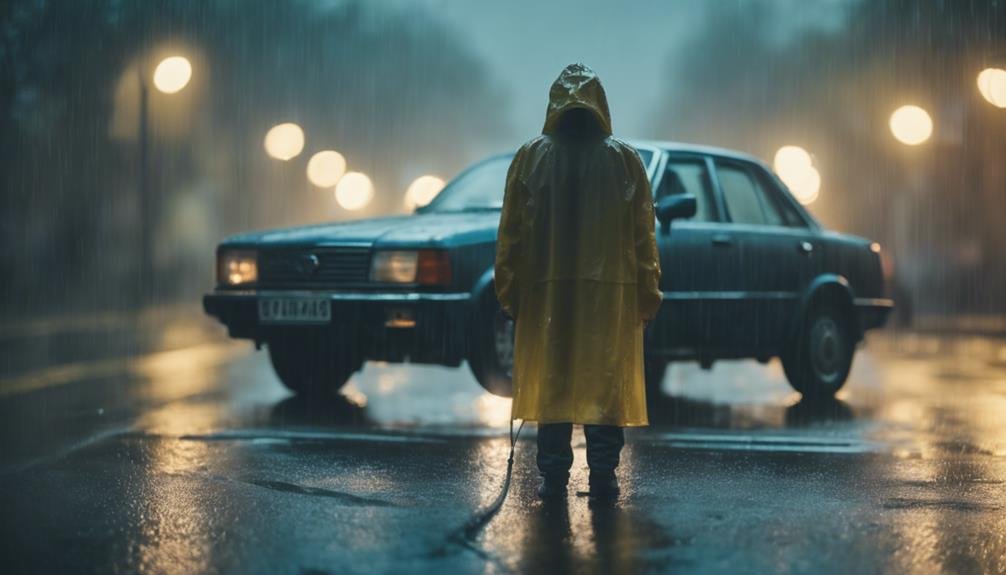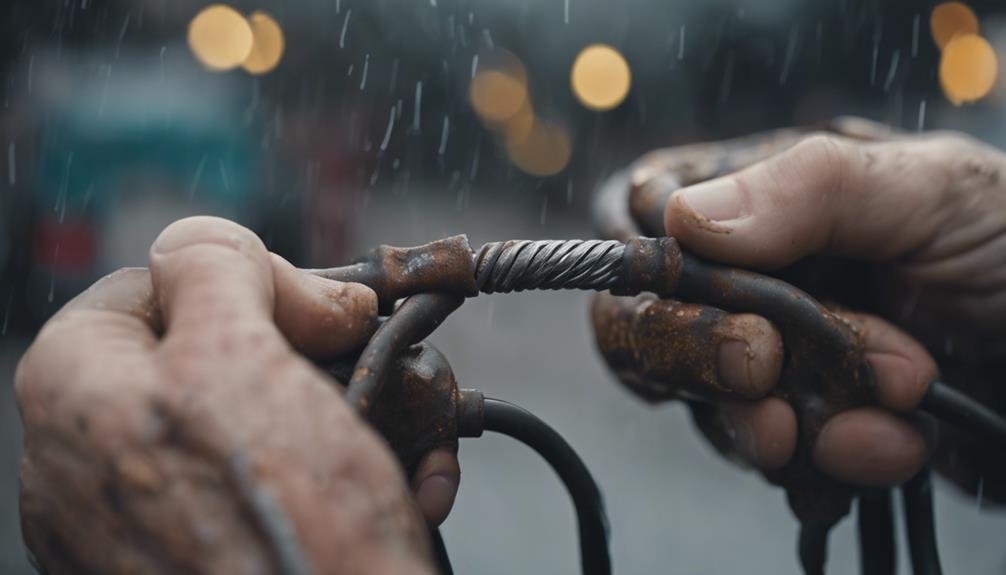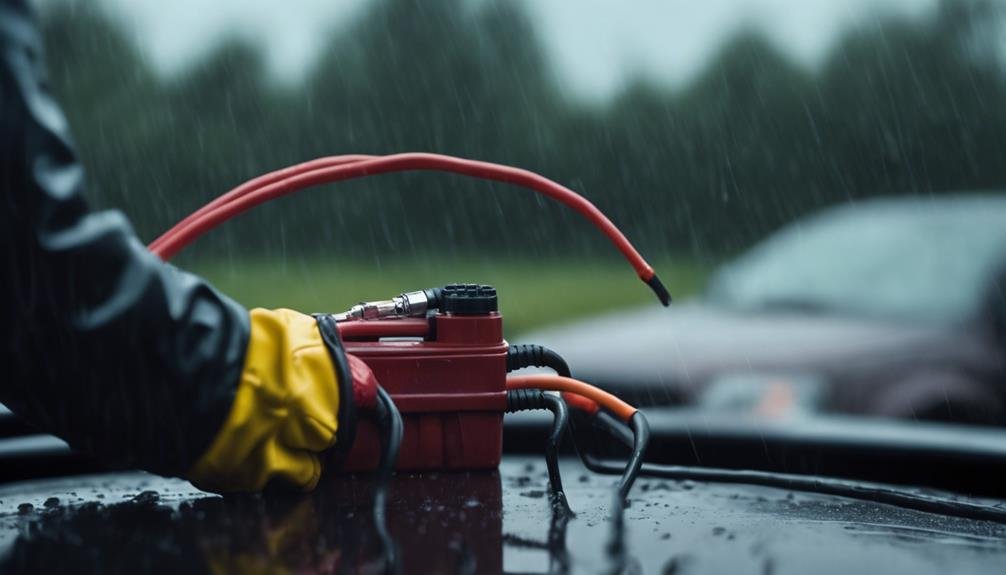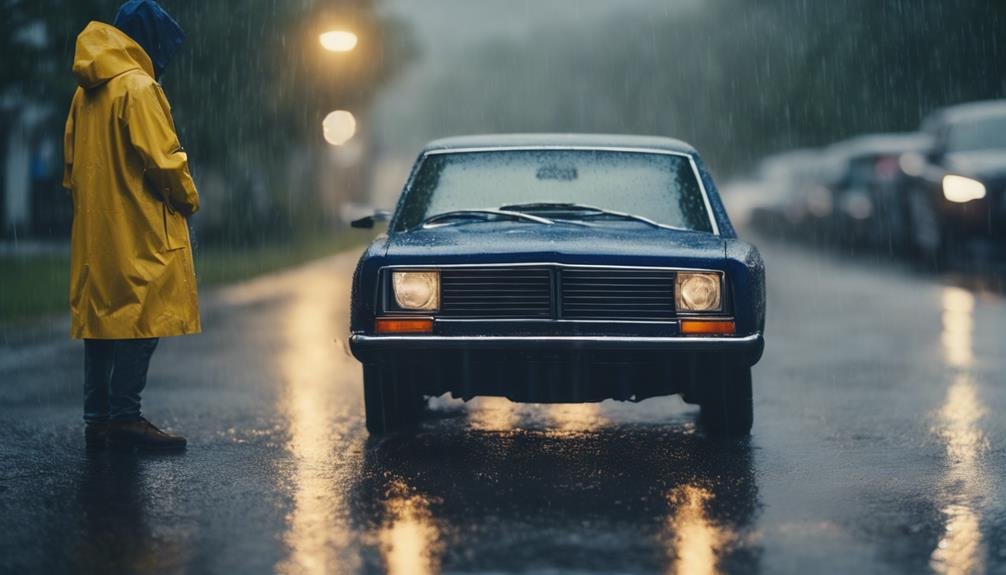When jump-starting a car in the rain, you face unique risks like electrical shocks, short circuits, and sparks that can ignite hydrogen gas near the battery. To guarantee a safe and successful jump-start, take proper safety precautions like wearing protective gear, standing on a non-conductive surface, and using insulated tools. Make sure the donor vehicle has a fully charged battery and the engines are turned off. Inspect jumper cables and terminals for damage, corrosion, or debris. By following these steps, you'll be well on your way to a successful jump-start; but there's more to know about this complex process, so proceed with caution.
Key Takeaways
- Jump-starting a car in the rain is risky due to increased electrical hazards and water conductivity, which can cause short circuits and sparks.
- Wear protective gear, including waterproof clothing, safety glasses, and insulated tools, to minimize the risk of electrical shock.
- Ensure both vehicles are parked on a level surface, facing each other, with the engines turned off, and the parking brake engaged.
- Inspect the jumper cables and terminals for damage, corrosion, or fraying before attempting a jump-start.
- After the jump-start, inspect the battery terminals and jumper cables again, and monitor the battery's performance to ensure the issue is resolved.
Risks of Jump-Starting in Rain
When you attempt to jump-start your car in the rain, you're taking a significant risk: water exposure increases the likelihood of electrical hazards, and even a slight mistake can have serious consequences.
Water conductivity can lead to short circuits and sparks while connecting jumper cables, which can be catastrophic. Accidental clamps touching or metal surfaces coming into contact can also cause sparks in wet conditions, further increasing the risk.
Additionally, the rain-soaked environment makes it difficult to securely handle jumper cables, as slippery surfaces can cause you to lose your grip.
To make matters worse, hydrogen gas near the battery can ignite during jump-starting in the rain, posing a potential explosion risk.
It's vital to understand that water exposure and electrical hazards go hand-in-hand, and the combination of the two can have devastating consequences.
As you consider jump-starting your car in the rain, bear in mind that the risks involved can be life-threatening, and it's important to weigh the risks against the benefits before proceeding.
Safety Precautions for Jump-Starting
To minimize the risks associated with jump-starting in the rain, you'll need to take specific precautions to protect yourself from electrical hazards. Jump-starting a car in wet conditions can be risky, and it's important to take the necessary safety measures to avoid electrical shocks and other hazards due to the rain.
When jump-starting, make sure to wear protective gear, including safety glasses, rubber gloves, and insulated tools to prevent electrical shocks. Stand on a dry, non-conductive surface, avoiding wet surfaces, puddles, or wet grass that can conduct electricity. Moreover, lay down a rubber mat or wear rubber-soled shoes for added protection during the process.
Be cautious of battery acid, which can cause burns and eye damage while jump-starting in rainy conditions. By taking these precautions, you can minimize the risks associated with jump-starting in the rain and guarantee a safe and successful process. Remember, safety should always be your top priority when working with electrical systems, especially in wet conditions.
Protecting Your Vehicle and Self

As you prepare to jump-start your car in the rain, shield yourself and your vehicle from the elements by donning waterproof gear and covering your engine with a custom-tailored cover. Protecting your vehicle and self is vital during the jump-starting process.
| Safety Measure | Description |
|---|---|
| Waterproof Gear | Wear waterproof clothing, gloves, and eye protection to shield yourself from wet conditions and potential electrical hazards. |
| Engine Cover | Use custom-tailored covers to protect your vehicle's engine and electronics from rainwater exposure during jump-starting. |
| Roadside Emergency Kit | Keep a kit with waterproof gear, tools, and first-aid supplies handy for any unforeseen circumstances. |
To securely jump-start your car in the rain, ensure proper illumination with a bright flashlight to assist in connecting jumper cables safely. Be cautious of slippery surfaces and electrical hazards like sparks or short circuits. By taking these precautions, you can minimize risks and protect yourself and your vehicle during the jump-starting process.
Finding a Suitable Donor Vehicle
With your vehicle and self protected, you'll need to find a suitable donor vehicle to provide the necessary power to jump-start your car in the rain.
When searching for a donor vehicle, look for one with a fully charged battery to guarantee successful jump-starting. Make sure the donor vehicle is parked close enough to yours, but not touching, to connect the jumper cables safely.
Before connecting the cables, check the donor vehicle's battery terminals for corrosion or dirt that could impact the jump-starting process in rainy conditions. Confirm that the donor vehicle's engine is turned off to prevent electrical mishaps during the jump-start.
Verify that both vehicles are facing each other, providing easy access to the battery terminals when jump-starting in the rain.
Inspecting Jumper Cables and Terminals

Before attempting to jump-start your car in the rain, inspect the jumper cables for any signs of damage, such as fraying or exposed wires, to guarantee a safe and successful connection. Check the cables for any signs of corrosion, which can weaken the connection and hinder the jump-starting process.
Next, inspect the battery terminals for corrosion or buildup that can impede the flow of electricity during a jump start in wet conditions. Make sure the terminals are clean and free of debris to secure a connection. Also, look for any signs of moisture or water accumulation near the battery terminals, as this can increase the risk of electrical shorts while jump-starting a car in the rain.
Confirm that the jumper cable clamps are clean and free of dirt or debris to establish a secure connection between the batteries. Verify that the jumper cables are long enough to reach between the two vehicles without stretching or straining, maintaining a safe distance during the jump-start process.
Safe Attachment of Jumper Cables
Now that you've inspected the jumper cables and terminals, you're ready to attach the cables safely to the batteries. To do this, you'll need to follow the correct procedure to avoid any potential risks.
Start by connecting the positive (red) cable to the positive terminal of the dead battery, then attach it to the positive terminal of the charged battery. Next, attach the negative (black) cable to an essential metal surface on the car with the charged battery, such as a bolt on the engine block or a metal bracket. This is vital to avoid damaging the electrical system.
As you attach the cables, keep them away from any moving parts or areas where sparks could ignite flammable materials.
By taking these precautions for jump-starting, you'll minimize the risk of electrical accidents. Remember to attach the cables securely to the battery terminals to prevent sparks and short circuits.
Starting the Vehicles Safely

Park your vehicles facing each other, guaranteeing easy access to the batteries, and then turn off both engines and engage the parking brakes to prepare for a safe jump-start in the rain. Next, connect the jumper cables in the correct order to start the vehicles safely.
| Step | Action |
|---|---|
| 1 | Attach one end of the positive (red) jumper cable to the positive terminal of the dead battery. |
| 2 | Attach the other end of the positive (red) jumper cable to the positive terminal of the good battery. |
| 3 | Attach one end of the negative (black) jumper cable to the negative terminal of the good battery. |
Keep your hands away from the metal clamps to prevent any electrical shock. Ensure the clamps touch only the correct terminals and don't cross or touch any metal surfaces. Now, get into the working vehicle and start the engine. Let it run for a few minutes to charge the dead battery. Once the dead vehicle's engine is running, remove the jumper cables in the reverse order they were attached.
Removing Jumper Cables Safely
Your priority is to disconnect the jumper cables in the correct order to avoid any electrical shock or damage to the vehicles.
To remove the jumper cables safely, start by disconnecting the black clamp from the unpainted metal surface on the car with the charged battery.
Next, carefully remove the black clamp from the negative terminal of the previously dead battery to prevent sparking.
After removing the black clamp, detach the red clamp from the charged battery's positive terminal.
Finally, make sure both vehicles are turned off before disconnecting the red clamp from the positive terminal of the previously dead battery.
Following these steps in the correct order will help you remove the jumper cables without causing any damage or hazards.
Remember, disconnecting the cables in the correct order is essential to prevent electrical shock or damage to the vehicles.
Post-Jump Start Safety Checks

After jump-starting your vehicle in the rain, you should perform several significant safety checks to make sure your vehicle is running smoothly and the battery is functioning properly. Initially, inspect the battery terminals for any signs of corrosion or damage, a common issue after jump-starting a car in wet conditions.
Check the jumper cables for any water damage or fraying that could affect future use. Next, make sure the engine of the previously dead vehicle is running smoothly, listening for any unusual sounds or smells coming from the engine block. This is vital to prevent further damage to your vehicle.
Moreover, monitor the battery's performance in the following days to ensure it holds a charge properly after being jump-started in the rain. By taking these precautions, drivers can minimize the risk of battery corrosion and guarantee their vehicle is safe to operate. Remember, a dead battery can be a major inconvenience, but with proper precautions, you can avoid common pitfalls and get back on the road quickly.
Troubleshooting Common Issues
If your car still refuses to start even after a successful jump-start, it's likely that a more serious issue is lurking beneath the surface. This could be related to your car battery, electrical components, or other critical systems.
Repeatedly attempting to jump-start a car with a faulty electrical component can cause potential harm, so it's important to troubleshoot common issues. Instead of risking further damage, consider seeking professional assistance or towing your vehicle to a repair shop.
A trained mechanic can provide a proper diagnosis for potential battery, alternator, or starter issues. They'll help identify the root cause, whether it's a faulty component or a more complex problem. Addressing the underlying issue is vital to prevent further damage and costly repairs.
Frequently Asked Questions
Can You Jumpstart a Car When It's Raining?
You can jumpstart a car in the rain, but be cautious – rain can affect the battery, so wear protective gear, use insulated tools, and keep cables away from water to avoid electrical hazards.
Is It Okay to Charge a Car Battery in the Rain?
You can charge a car battery in the rain, but you're wise to take precautions, ensuring the charger is waterproof and keeping it away from standing water to avoid electrical shocks or short circuits.
Can Jumping a Car Damage It?
When you jump-start a car, you risk damaging the electrical system, especially if the batteries are old or weak. You could blow a fuse, overload the alternator, or short circuit the system, causing costly repairs.
Does a Car Have to Be Running to Jump Another Car?
'No, you don't need a running car to jump another; the donor battery's power is used to start the dead one, so make sure the donor car is running during the jump-start process.'
Conclusion
You've now successfully jump-started your car in the rain, taking necessary precautions to guarantee your safety and the safety of your vehicle.
Remember to double-check all connections, start the functioning vehicle initially, and monitor your car's electrical system.
By following these steps, you've minimized risks and got back on the road quickly, even on a rainy day.
